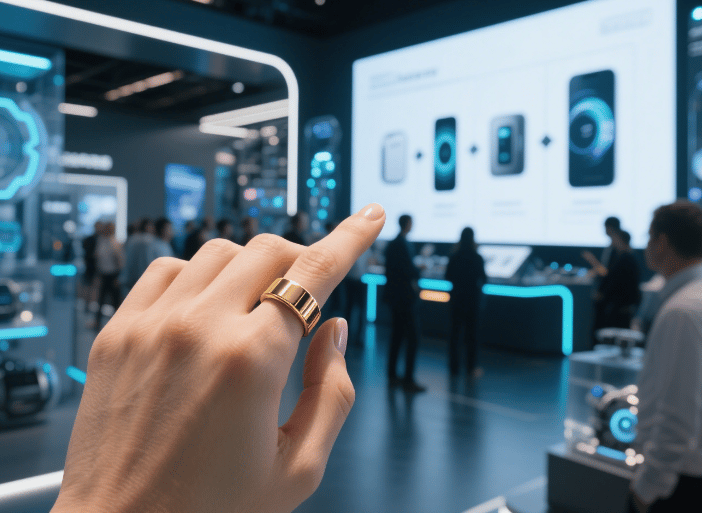The Potential and Applications of Smart Rings in the Healthcare and Medical Fields
7/7/20254 min read
Introduction to Smart Rings
Smart rings represent a significant advancement in the wearable technology landscape, offering a compact and versatile alternative to traditional health-monitoring devices. Designed to be lightweight and unobtrusive, these rings incorporate sophisticated technology to track a variety of health metrics seamlessly. Unlike smartwatches or fitness bands that typically occupy the wrist, smart rings provide a more discreet option without compromising functionality. Their small form factor allows users to wear them comfortably throughout the day and night.
The development of smart rings has been fueled by advances in sensor technology and miniaturization techniques, enabling the integration of health-monitoring capabilities within a ring-sized device. Typically made from durable materials such as titanium, ceramic, or medical-grade plastics, these rings are not only aesthetically pleasing but also designed to withstand daily wear and tear. Their sleek designs cater to various personal styles, making them appealing to a broader audience.
Smart rings often come equipped with a range of features that make them stand out in the realm of health monitoring. Common functionalities include heart rate tracking, sleep analysis, and activity recognition. Some models even offer advanced features such as blood oxygen level monitoring and stress tracking, emphasizing their potential role in personal health management. The data collected by smart rings are typically synchronized with mobile applications, providing users with actionable insights into their health and wellness trends over time.
As wearables continue to evolve, the integration of smart rings into healthcare systems holds considerable promise. They offer a new avenue for patients to engage with their health data proactively, paving the way for innovative medical applications and potentially transforming how individuals monitor and manage their health. In summary, smart rings represent a valuable addition to the array of wearable health devices, combining cutting-edge technology with user-friendly design to enhance health monitoring capabilities.
Benefits of Smart Rings in Health Monitoring
Smart rings have emerged as a valuable tool in health monitoring, providing comprehensive benefits that enhance individual well-being. One of the primary advantages is their capability for continuous health monitoring. Unlike traditional methods that necessitate periodic check-ups, smart rings collect real-time data regarding various health metrics. This ongoing analysis enables individuals to track changes in their heart rate, sleep patterns, and physical activity, thereby fostering a proactive approach to health.
Another significant benefit is the potential for early detection of health issues. Smart rings use sophisticated sensors to monitor physiological parameters, which can help identify abnormal patterns that may indicate underlying health problems. For instance, fluctuations in heart rate or variations in sleep quality can serve as early warning signs of conditions such as sleep apnea or cardiovascular issues. Consequently, timely interventions can be initiated, allowing individuals to seek appropriate medical advice before conditions escalate.
Furthermore, personalized healthcare is greatly supported by smart ring technology. By collecting extensive health data, these devices facilitate tailored health recommendations based on individual needs and current health status. Such personalized insights empower users to make informed lifestyle choices, enhancing their overall health outcomes. The integration of artificial intelligence and data analytics into smart rings also plays a crucial role in identifying trends and patterns in health data. For example, a study conducted by healthcare researchers revealed that individuals using smart rings experienced a 20% improvement in managing their stress levels, thanks to the insights gained from their personal health data.
In conclusion, the proliferation of smart rings in health monitoring exemplifies their transformative potential. With continuous tracking, early detection, and personalized healthcare opportunities, these innovative devices not only enhance individual health management but also contribute to improved medical outcomes, making them an invaluable asset in today’s healthcare landscape.
Applications of Smart Rings in Medical Settings
Smart rings have emerged as a transformative technology within the healthcare sector, offering diverse applications that enhance patient care and monitoring. One of the primary functions of smart rings is patient monitoring. These devices can collect vital health metrics, such as heart rate, sleep patterns, and oxygen saturation levels, in real-time. Healthcare professionals can utilize this data to keep a constant check on patients' conditions, allowing for timely interventions when necessary. This continuous monitoring is particularly beneficial for patients with chronic illnesses, providing healthcare teams with critical information to guide treatment decisions.
In addition to real-time monitoring, smart rings enable remote diagnostics. This is particularly advantageous for patients in rural or underserved areas, where access to medical facilities may be limited. By connecting with smartphones or other devices, smart rings can transmit data directly to healthcare providers, facilitating virtual consultations and reducing unnecessary hospital visits. This approach not only optimizes resource utilization but also enhances patient convenience and satisfaction.
Chronic disease management stands out as one of the most promising applications of smart rings. Devices can empower individuals to better understand and manage their conditions while enhancing engagement with healthcare providers. For instance, case studies have shown that integrating smart rings into the treatment plans of diabetes patients can lead to improved glycemic control and adherence to medication schedules. Furthermore, regulatory and ethical considerations must be carefully weighed in its implementation. Issues surrounding data privacy and security require rigorous attention to ensure that patient information remains confidential and is used solely for medical purposes.
As smart ring technology continues to evolve, the potential for its application in medical settings will likely expand even further, providing innovative solutions to longstanding healthcare challenges.
The Future of Smart Rings in Healthcare
The future of smart rings in healthcare appears promising, marked by emerging technologies and innovative integrations that hold the potential to transform personal health management. As advancements in sensor technology and miniaturization continue, smart rings are expected to incorporate more sophisticated health monitoring features, such as continuous glucose monitoring, blood pressure tracking, and even early detection of cardiovascular issues. These capabilities will empower patients to take a proactive approach to their health, allowing timely interventions and better chronic disease management.
Moreover, the potential integration of smart rings with other medical devices, such as wearables and telemedicine platforms, is likely to enhance the effectiveness of healthcare solutions. For instance, real-time data collected by smart rings could be seamlessly shared with healthcare providers, enabling more informed decision-making and personalized treatment plans. This interconnectedness between devices not only facilitates better patient outcomes but also contributes to a deeper understanding of population health trends.
Despite the potential benefits, several challenges must be addressed before smart rings can achieve widespread adoption in healthcare. Data security and privacy concerns remain critical issues, as the sensitive health information collected by these devices is susceptible to breaches and unauthorized access. Ensuring robust cybersecurity measures and compliance with regulations, such as HIPAA, will be essential in building consumer trust and encouraging market acceptance.
Furthermore, the market must also overcome hurdles related to consumer awareness and education regarding the capabilities of smart rings. As healthcare technology continues to evolve, public perception and understanding of these devices will be pivotal in facilitating their acceptance. In essence, as smart rings continue to advance, they promise to revolutionize personal health management while simultaneously addressing challenges related to security and market acceptance.


